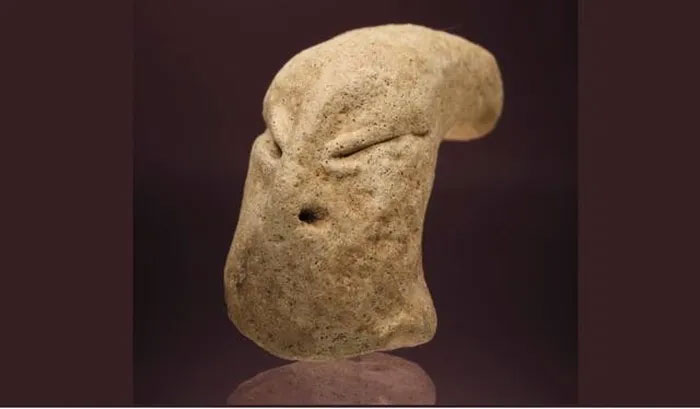'Snake Man' reveals 7,500-year-old civilization in West Asia
Traces of a mysterious civilization have appeared in the Al-Subiyah desert in West Asia, in the form of a strange clay head.
Traces of a mysterious civilization have appeared in the Al-Subiyah desert in West Asia, in the form of a strange clay head.
Scientists call the clay head they found a "snake man," representing a mysterious prehistoric civilization that thrived in the area from 5500 to 4900 BC.
The "Snake Man" was discovered at the Bahra 1 site in the Al-Subiyah Desert in northern Kuwait and analyzed by a team led by Polish freelance archaeologist Piotr Bieliński.

The "snake man" statue from the mysterious Ubaid civilization - (Photo: Adam Oleksiak/CAŚ UW).
The nickname "snake man" was given because the face of the newly excavated statue closely resembles the snake man image in Ubaid culture, with a long skull, flat nose, no mouth and narrow, squinted eyes.
The Ubaid people are considered to be the first intelligent population to appear in Mesopotamia, but data about them is very scarce.
Preliminary examination results show that the newly excavated artifacts most likely belong to this ancient civilization, contributing important evidence of the spread of Ubaid customs and beliefs across West Asia.
The presence of this strange face at various Ubaid sites raises interesting questions about its purpose, symbolic value or ritual value it had for the Ubaid people.
In addition to snake-faces, Ubaid artisans also often created unusually slender female figures with bird or lizard heads.
Long before the Sumerians established one of the earliest and most brilliant civilizations in Mesopotamia, the Ubaid people laid the foundations for it with a society that had many interesting characteristics.
The evidence they left behind is traces of trade networks, irrigation systems, and even amazing temples across what is now Iraq and Kuwait, along with a unique style of pottery that distinguishes them from other cultures.
Their pottery was often made from dried plants embedded in clay.
Ubaid Pottery - (Photo: Adam Oleksiak/CAŚ UW).
Thus, finding examples of Ubaid pottery and crafts not only allows researchers to connect the site to a larger story of the Ubaid cultural network, but also helps to re-describe the regional ecosystem more than seven millennia ago.
Archaeologist Roman Hovsepyan from the Institute of Archaeology and Ethnology NAS RA (France), a member of the research team, said that the plants in the clay that made up Ubaid pottery contained, in addition to wild plants, remains of cultivated plants.
They include barley, wheat and many other cereals, representing an incredibly developed agriculture 7,500 years ago.
- Strange hunting method of snake water
- Asia is still at risk of catching Ebola
- The 1,400-year-old stone tablet reveals a spooky Mayan truth
- Shocking discovery: The world 'timeless' thousands of years in Asia
- Former Canadian Defense Minister reveals: Is there an unknown civilization hidden under the ice in Antarctica?
- Greedy snake snakes tried to swallow snake but failed
- Colorful Asia welcomes the Lunar New Year
- Snake venom resistant serum: Is it ever enough?
- Strange is the snake 'Satan' appeared in Vietnam
- Snake and custom of worship of Vietnamese people
Kerma: The Mysterious Civilization of the Nile Former Canadian Defense Minister reveals: Is there an unknown civilization hidden under the ice in Antarctica? Indus Valley Civilization: Ancient city of Mohenjo-daro, battlefield of ancient nuclear weapons? Trypillia - Ukraine's mysterious primitive civilization Mysterious civilization in the Western Hemisphere Aztec - mysterious many civilizations The wonderful beauty of the sacred valley of the Incas Unravel the mysteries of the ancient city of Palmyra
